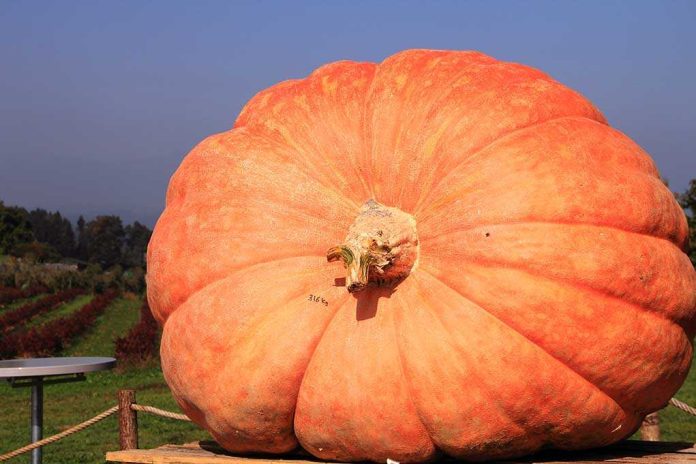
That festive orange pumpkin on your porch might be more than just a symbol of autumn—it could be harboring a toxic secret that’s been overlooked for years, putting your family’s health at risk when you least expect it.
Story Highlights
- Scientific studies reveal pesticide residues and heavy metals in commercially grown pumpkins.
- Regulatory oversight of pumpkin contamination is inconsistent and less rigorous than for major staple crops.
- Public health advisories issued in 2024 urge consumers to wash and peel pumpkins to reduce exposure.
- Growing consumer demand for organic pumpkins signals a shift in buying habits and regulatory scrutiny.
The Hidden Contaminants Lurking in Plain Sight
Americans have trusted pumpkins as a symbol of innocence and tradition, yet recent research shatters this perception. Multiple investigative reports from 2022 to 2024 found that pumpkins sourced from leading U.S. retailers often contained pesticide residues and, in some cases, heavy metals absorbed from contaminated soils. Scientists discovered that pumpkins, like other cucurbits, can act as sponges for chemicals left behind by modern agricultural practices. This isn’t merely academic: when autumn arrives and pumpkin consumption spikes, so too does the risk of ingesting substances linked with chronic health effects.
Regulatory agencies such as the EPA and FDA have established maximum residue limits, but pumpkins rarely receive the rigorous testing reserved for staple crops like apples or spinach. In 2024, the Environmental Working Group (EWG) and Consumer Reports published alarming findings: some pumpkin samples exceeded recommended thresholds for specific pesticides. The FDA, responding to mounting pressure, issued an advisory in October 2024 recommending consumers thoroughly wash and peel pumpkins before use. Despite these steps, enforcement gaps and inconsistent monitoring mean that contaminated pumpkins still reach supermarket shelves during the season when families are most likely to buy them.
How Industry and Oversight Shaped the Problem
Industrial agriculture’s expansion over the last decade fueled heavy reliance on synthetic pesticides and fertilizers to maximize yields and profits. Pumpkins, typically grown in rotation with other crops, often inherit the chemical legacy of their predecessors. Soil contaminated with heavy metals or persistent pesticides becomes an invisible threat, and because pumpkins are not viewed as a daily staple, they remain low on regulatory priority lists. Industry groups argue that residue levels detected remain within legal limits and pose minimal risk, but consumer advocates and pediatric health experts counter that chronic, low-level exposure—especially in children—warrants far more caution. This tug-of-war between industry, regulators, and advocacy groups has left the public caught in the middle, uncertain about what’s truly safe.
Farmers face their own dilemmas. Conventional growers risk economic losses as news of contamination spreads, driving consumers toward organic produce. Meanwhile, the cost and complexity of transitioning to certified organic practices act as significant barriers, especially for small-scale operators. Retailers, wary of reputational damage and liability, have begun sourcing more pumpkins from certified organic suppliers, but supply is limited and prices are higher, shifting the burden onto consumers. The result is a fragmented landscape, where food safety standards vary and transparency remains elusive.
The Consumer Ripple Effect—And What Comes Next
Short-term fallout from these revelations is already visible. Consumers are more cautious, with demand for organic pumpkins surging and families scrutinizing the origins of their autumn produce. Retailers scramble to reassure shoppers, while advocacy groups intensify calls for comprehensive testing and clearer labeling. Meanwhile, vulnerable populations—especially children and pregnant women—remain at heightened risk, as chronic exposure to even low levels of certain pesticides has been linked to developmental and neurological effects. The American Academy of Pediatrics and experts like Dr. Jennifer Sass emphasize that minimizing pesticide exposure in food is a prudent, common-sense measure that aligns with long-standing conservative values: better safe than sorry, especially when it comes to our children’s health.
Longer term, the pumpkin scandal could trigger broader reforms in how non-staple crops are regulated and tested. There is mounting pressure on agencies to apply the same rigorous standards and enforcement to all produce, not just the most popular. Farmers may be nudged toward integrated pest management and more sustainable practices as consumers vote with their wallets. The pumpkin tale could prove a turning point, not just for this iconic gourd but for the entire produce aisle—raising the bar for transparency, safety, and public trust just in time for next year’s harvest.
Sources:
Times of India: Pumpkins could be absorbing poison—here’s what researchers discovered
IFL Science: Your Halloween Pumpkin Could Be Concealing Toxic Chemicals—And Now We Know Why
ScienceDaily: Your pumpkin might be hiding a toxic secret
SciTechDaily: Scientists Finally Discover Why Pumpkins Absorb Pollution









